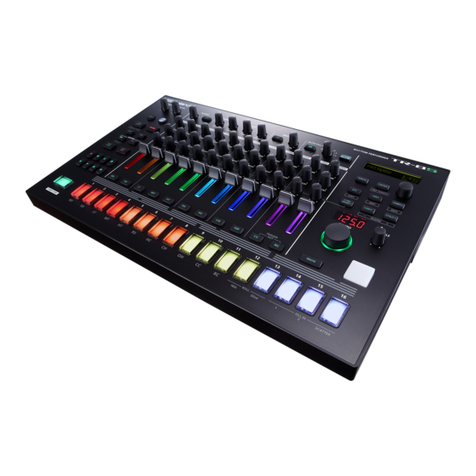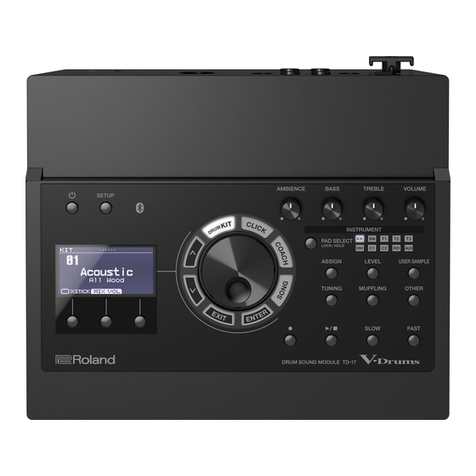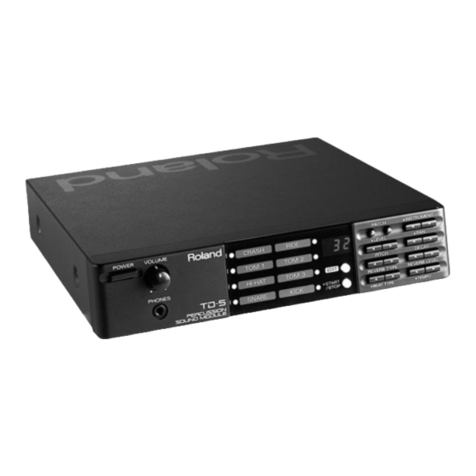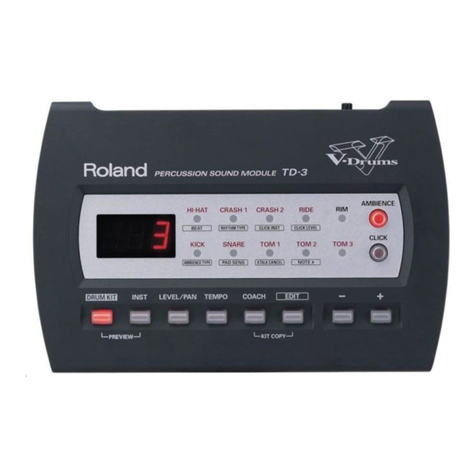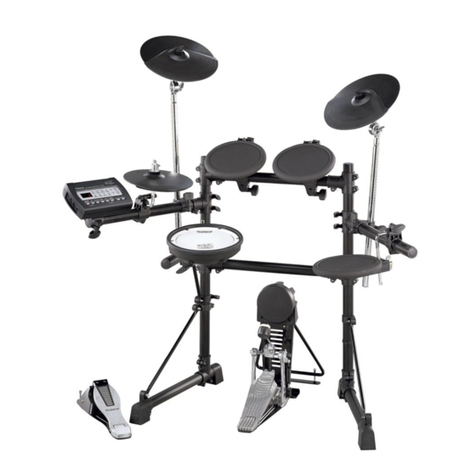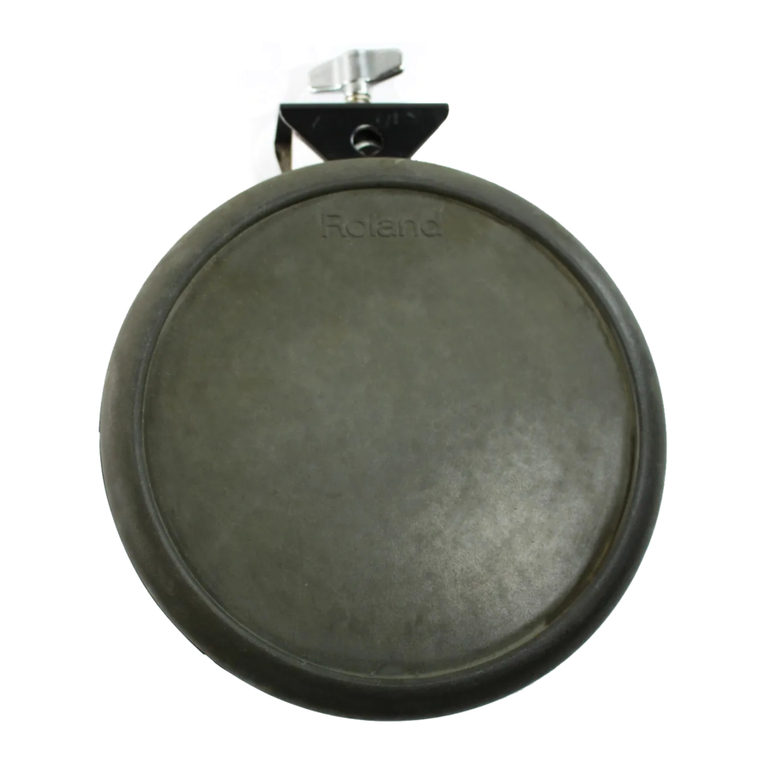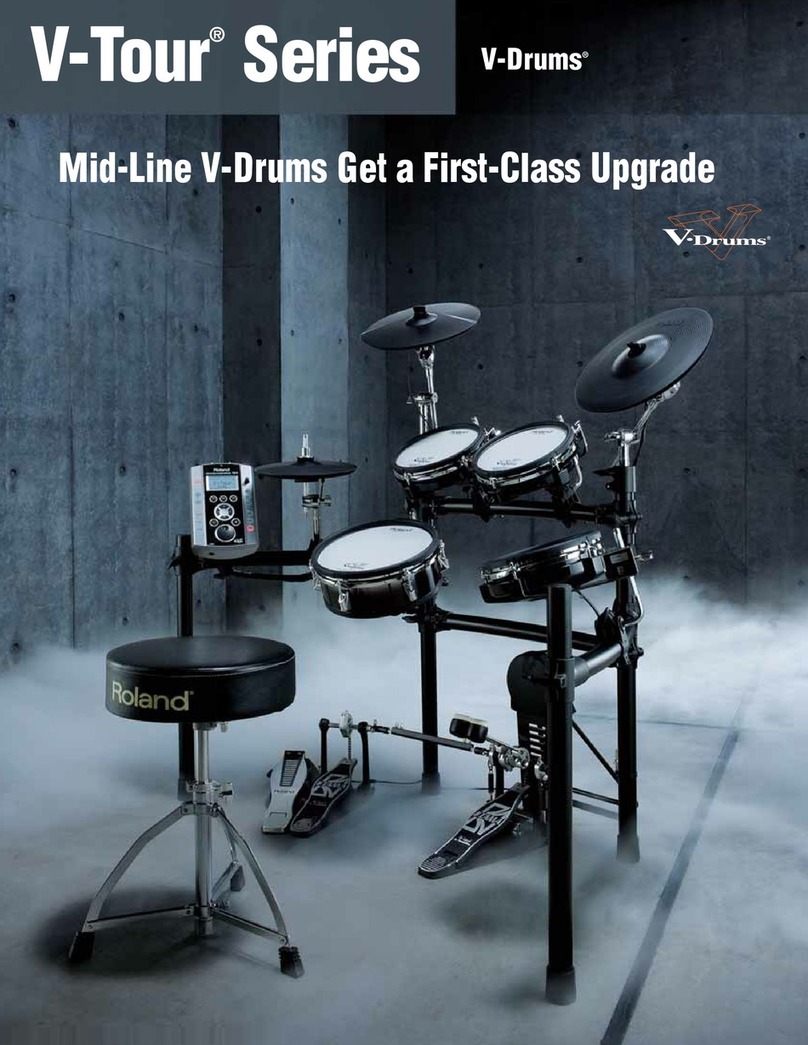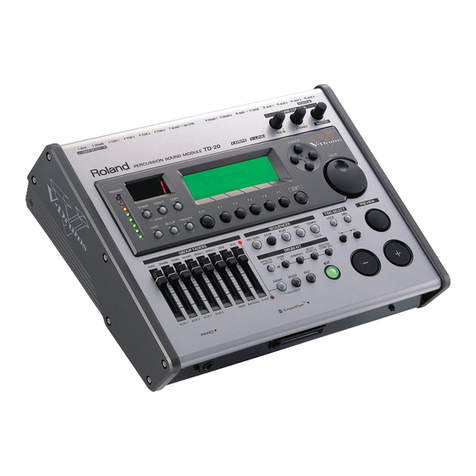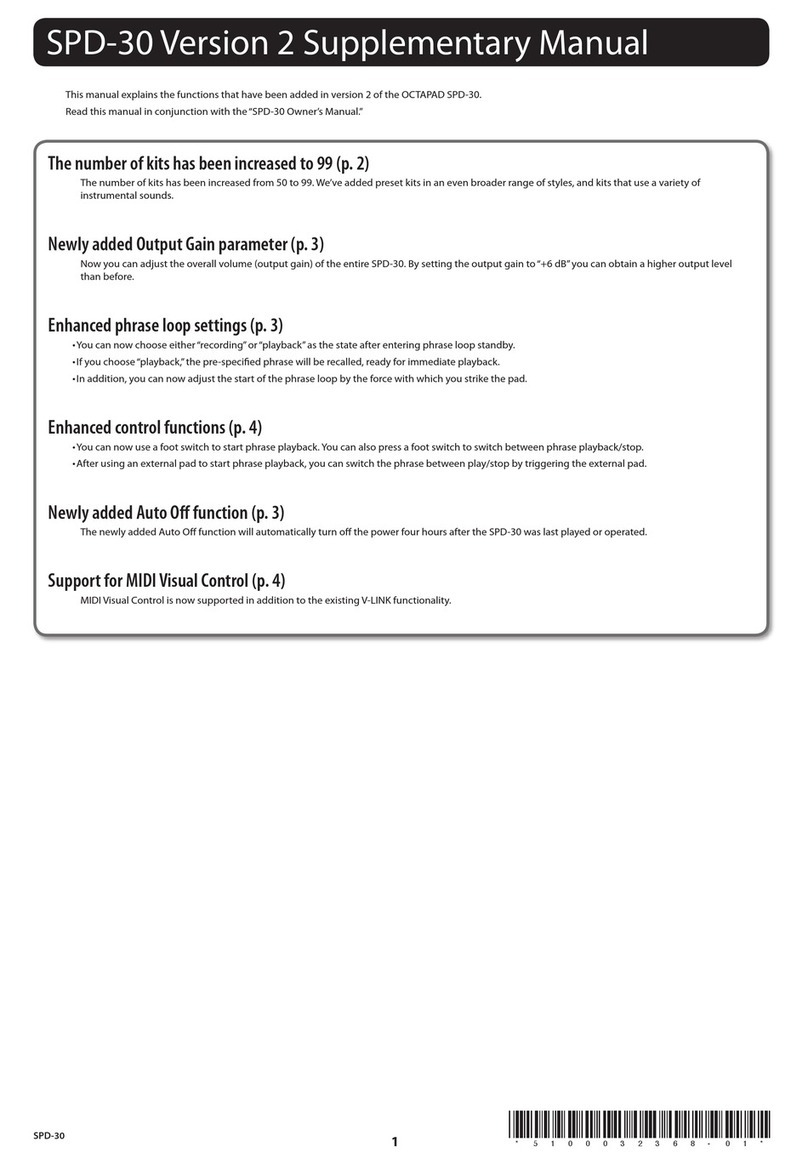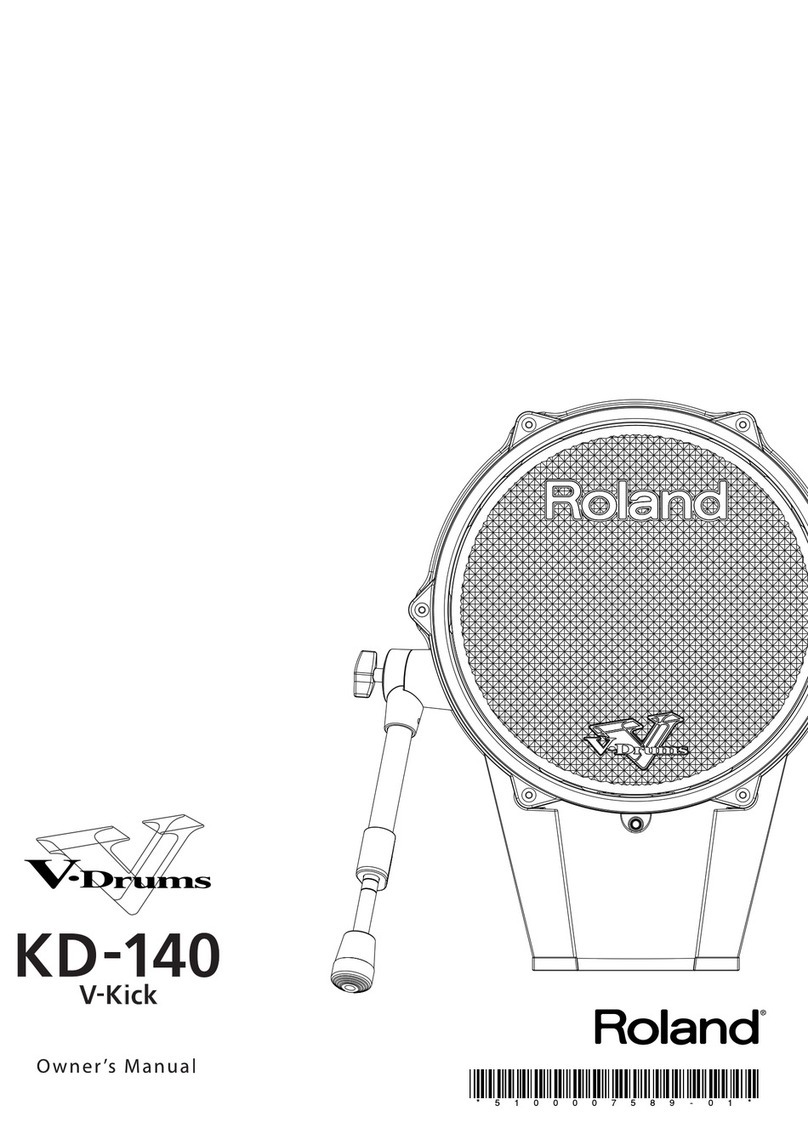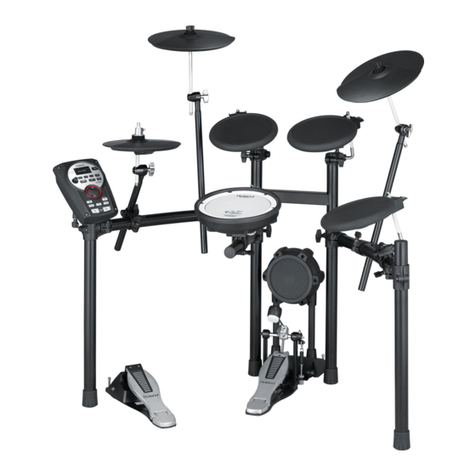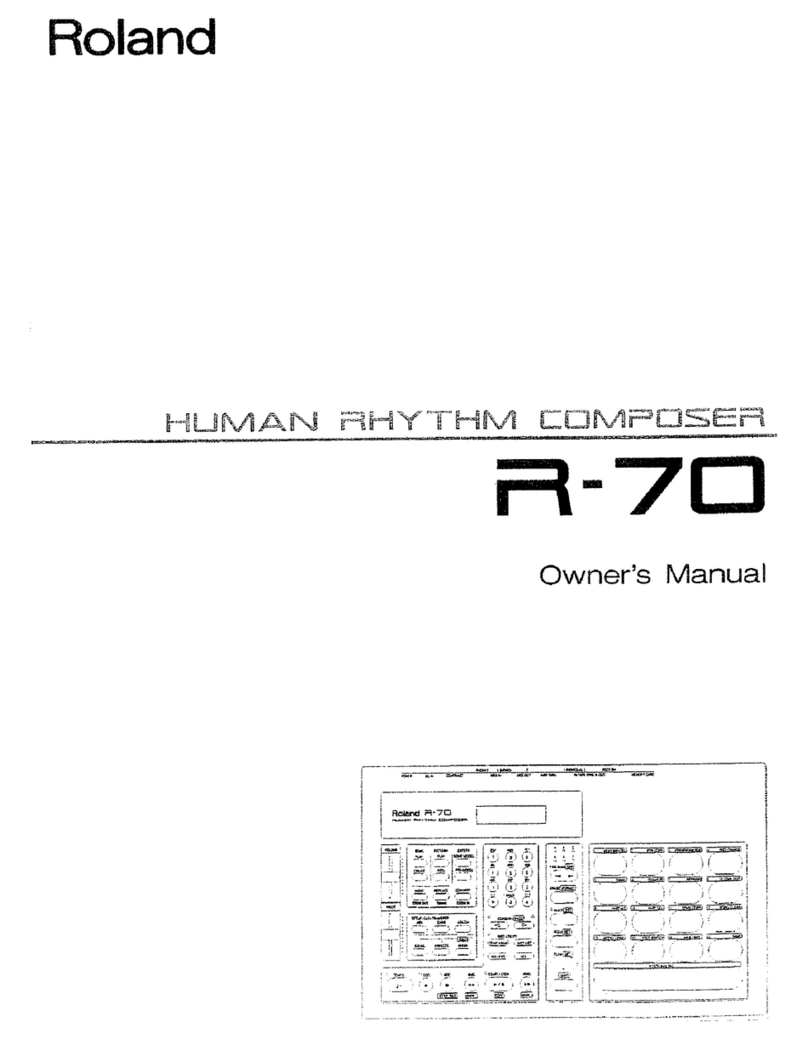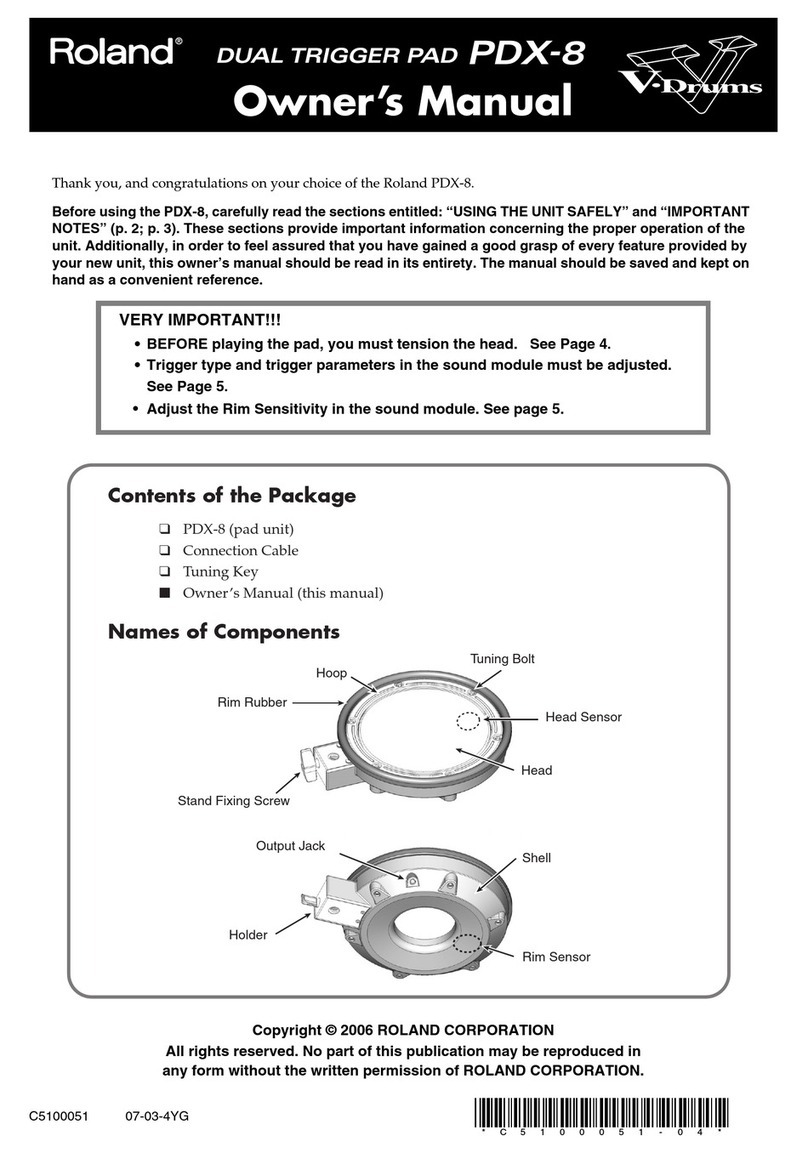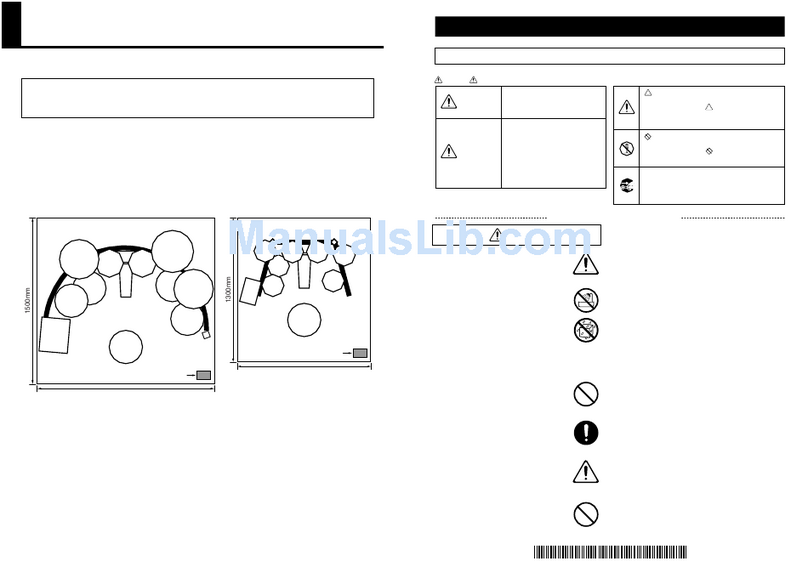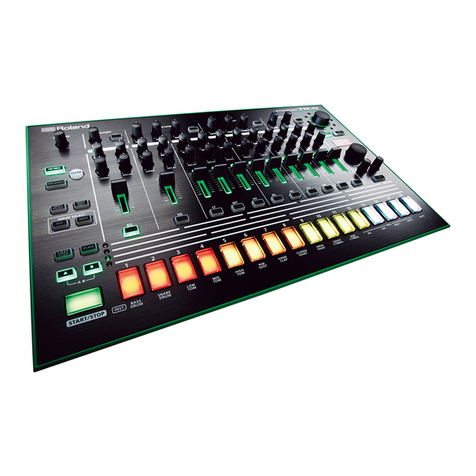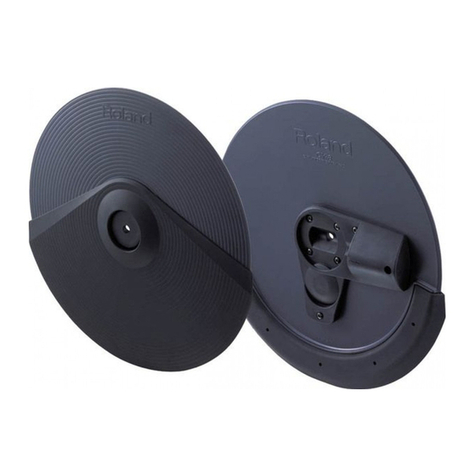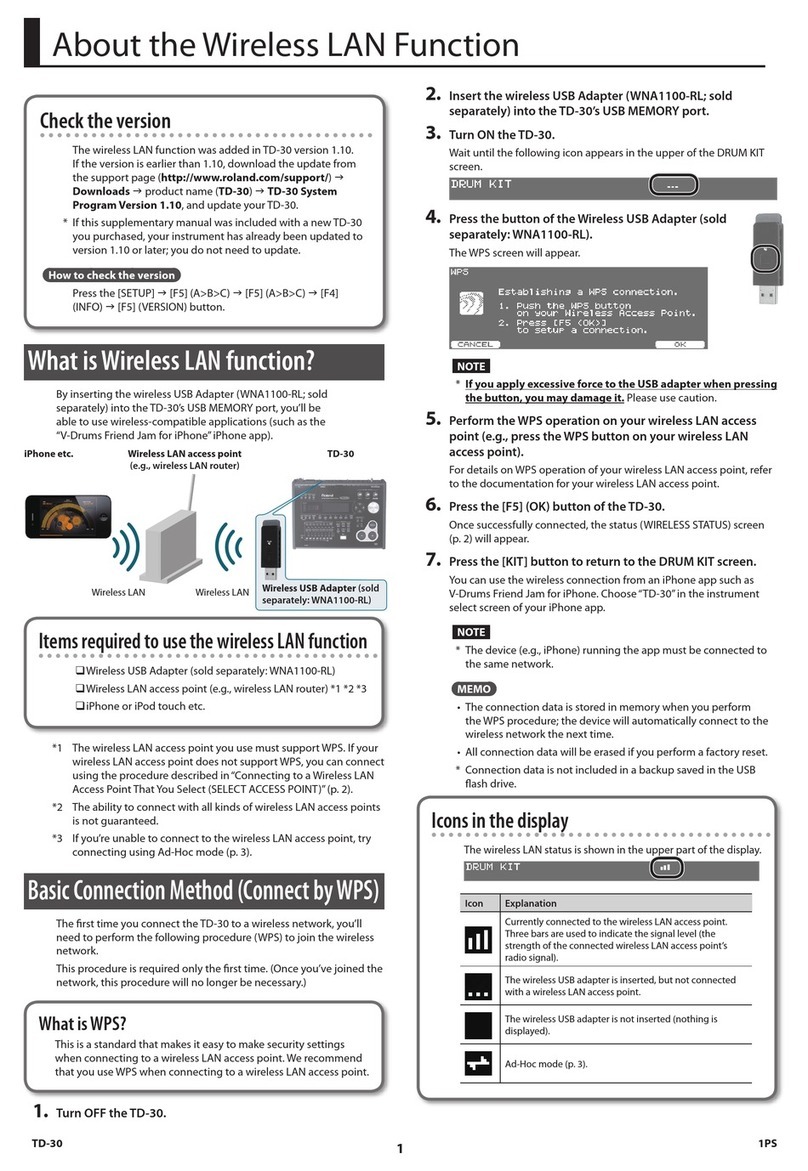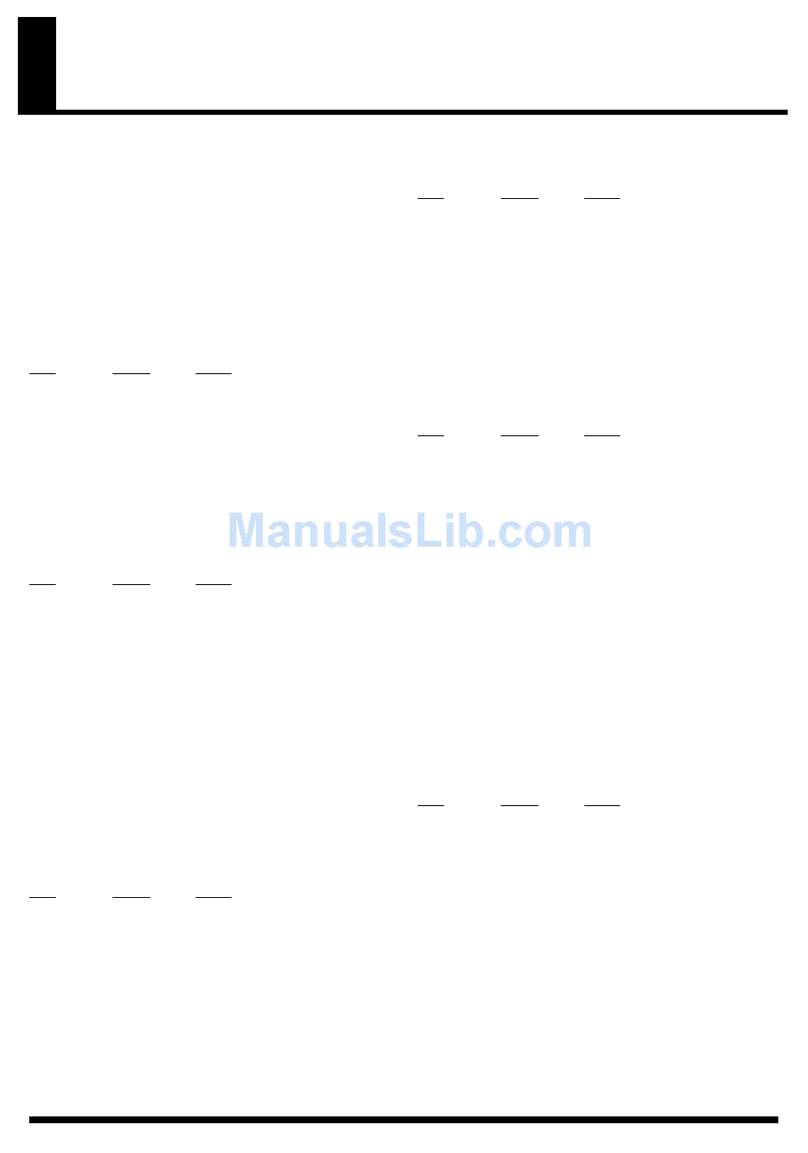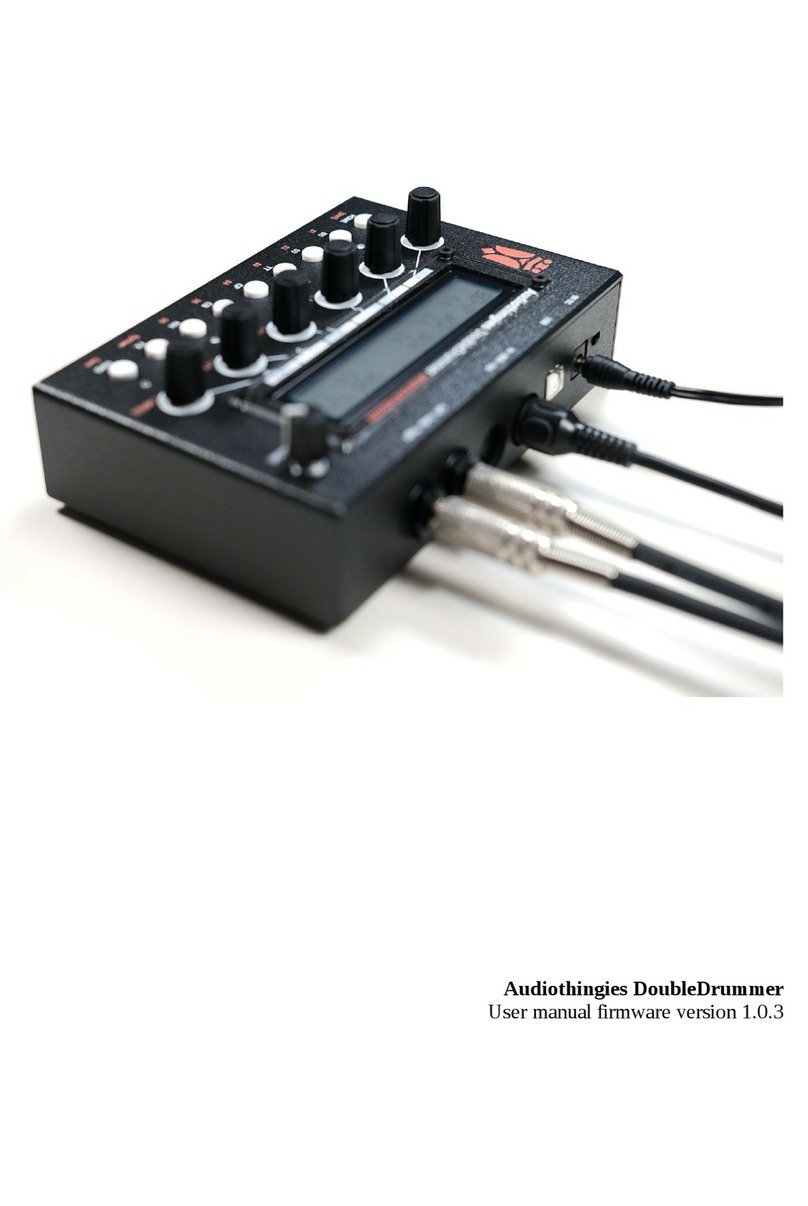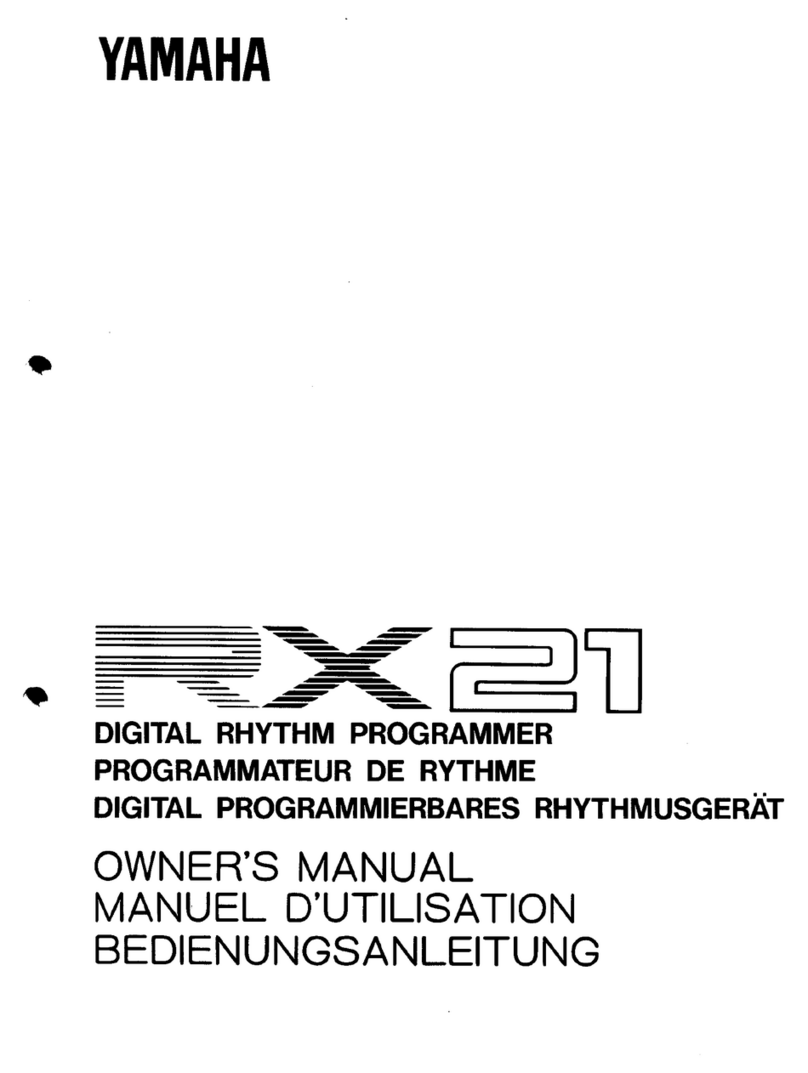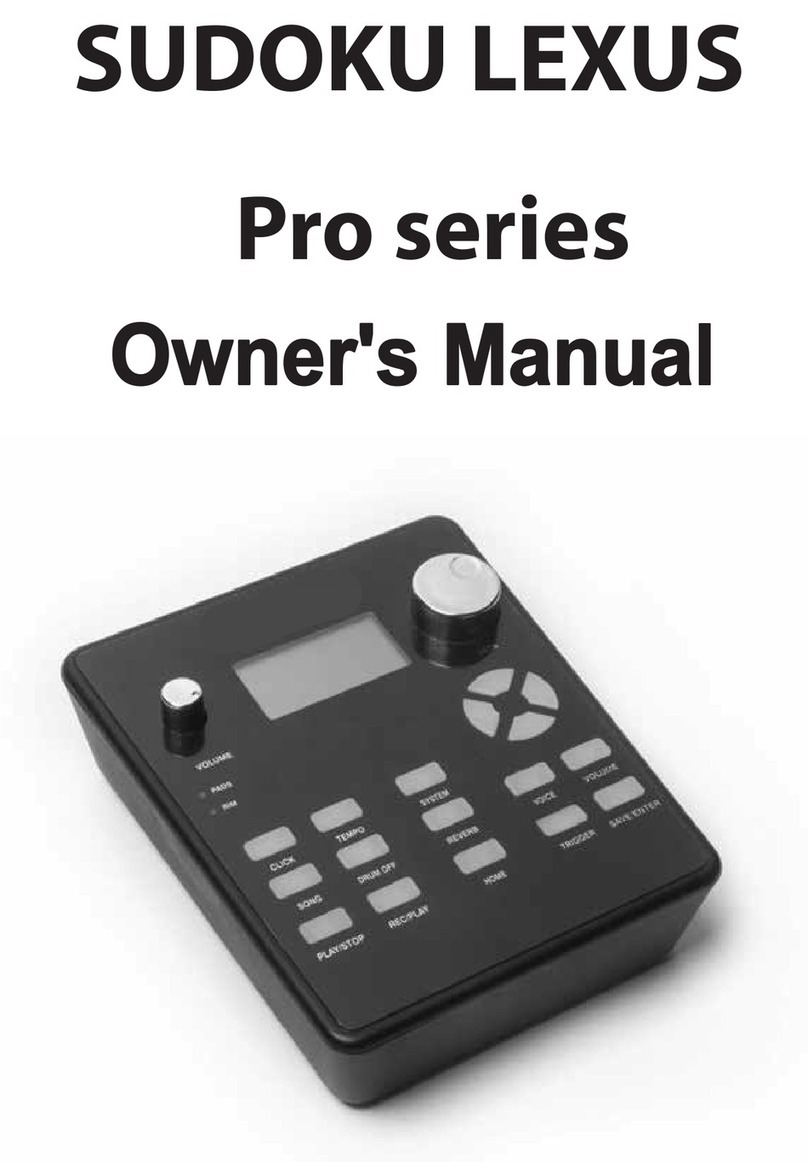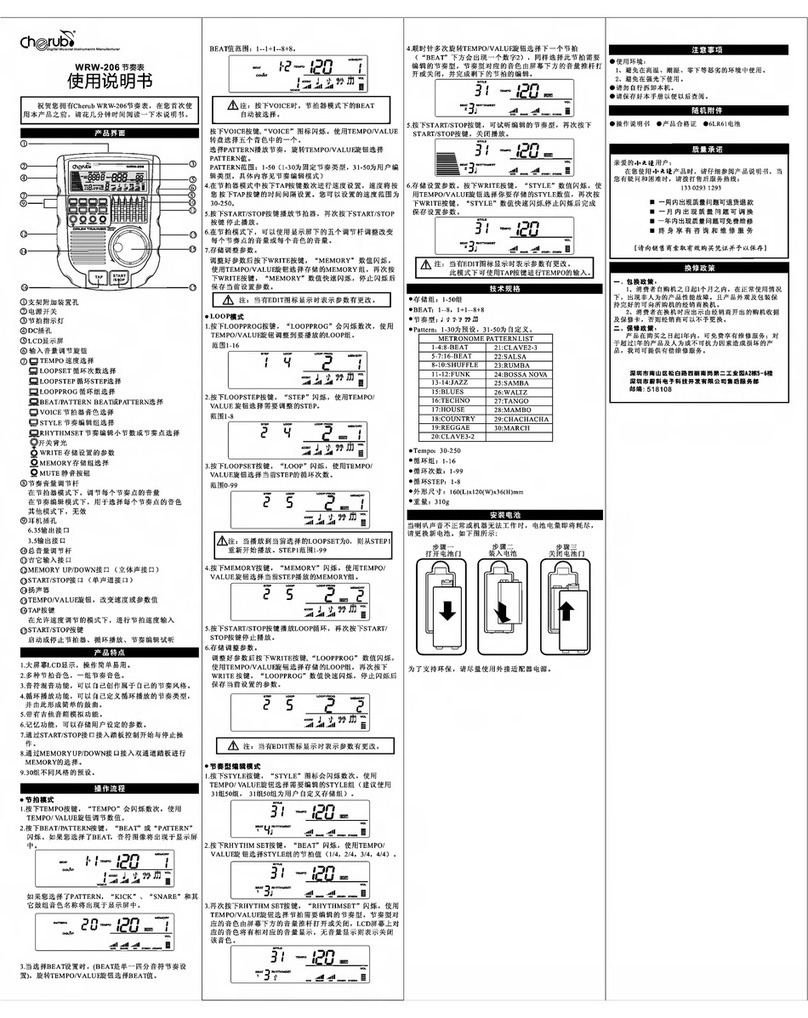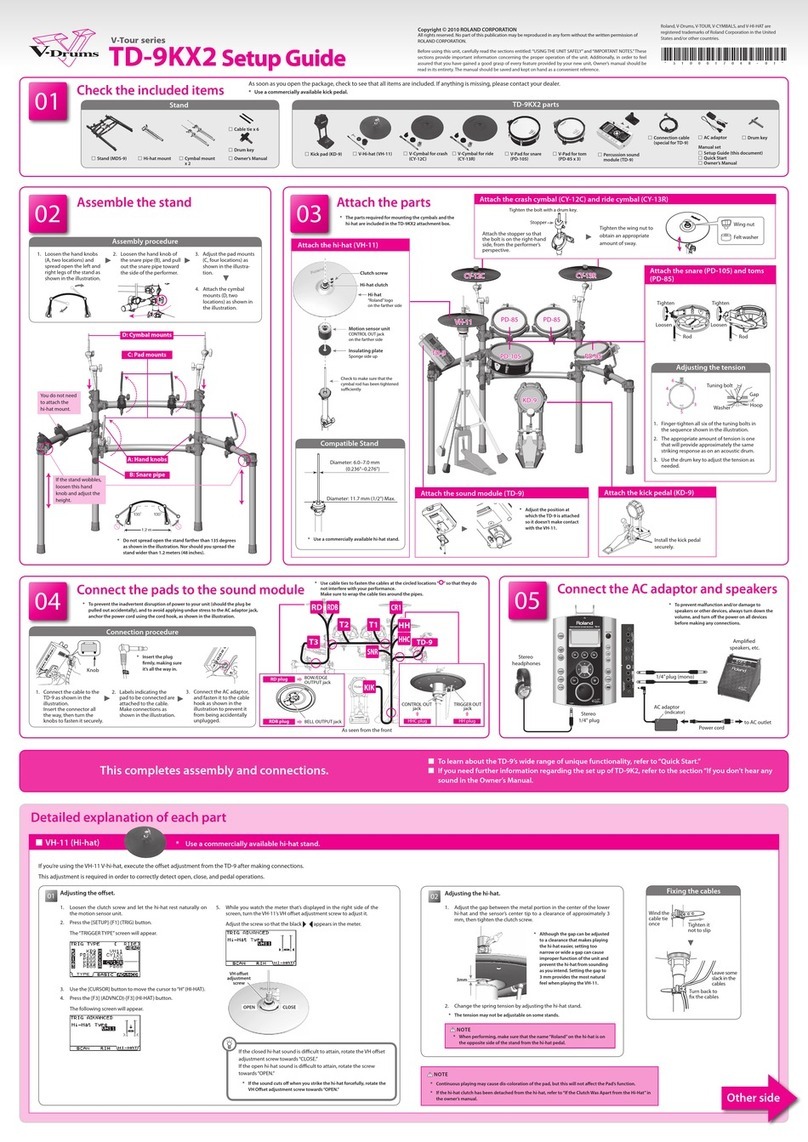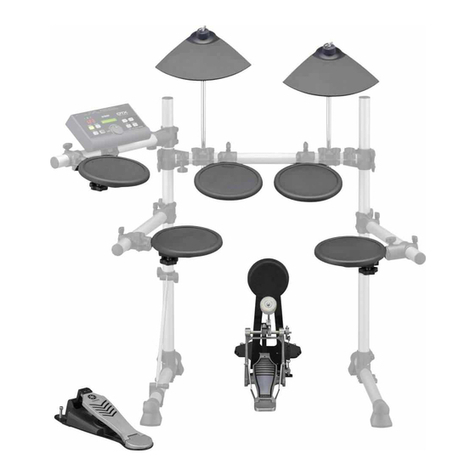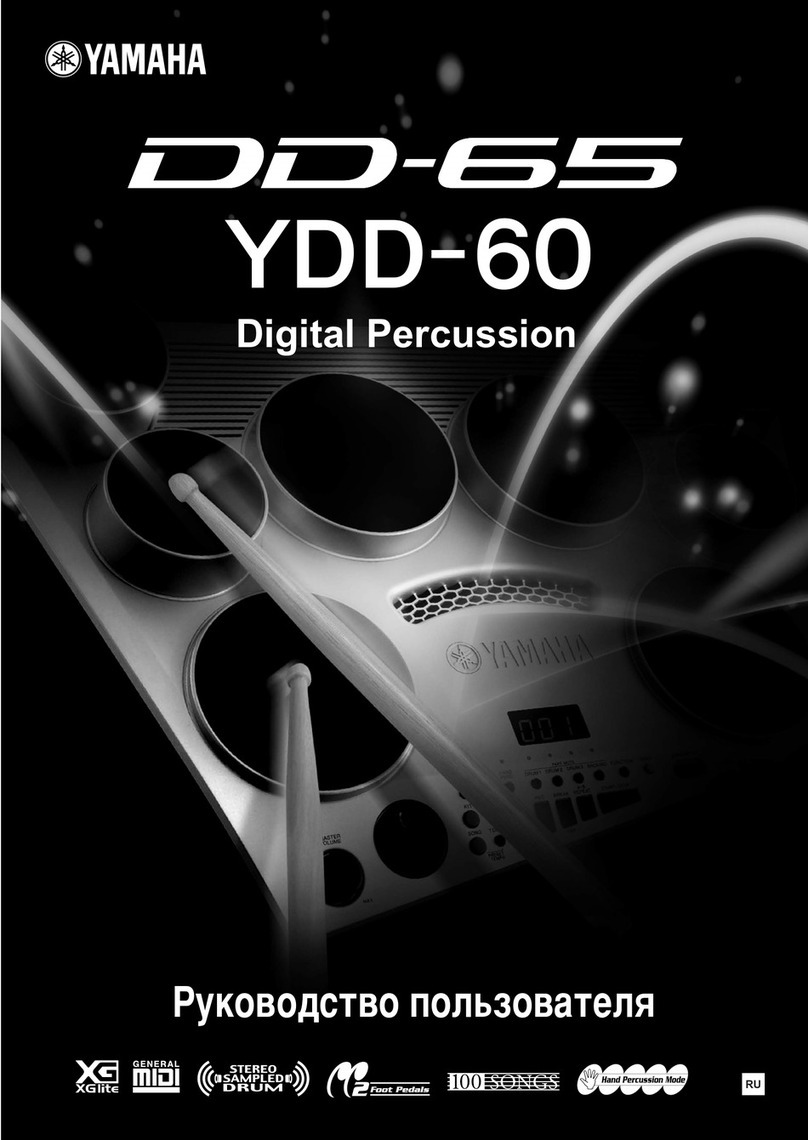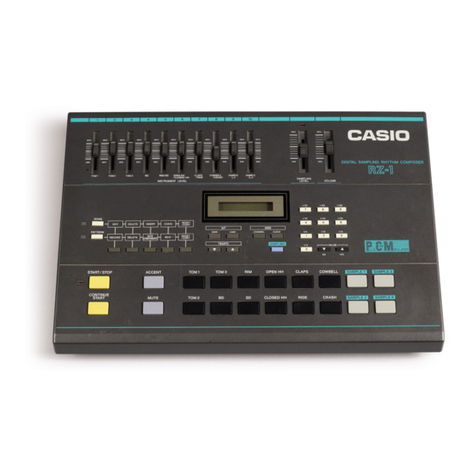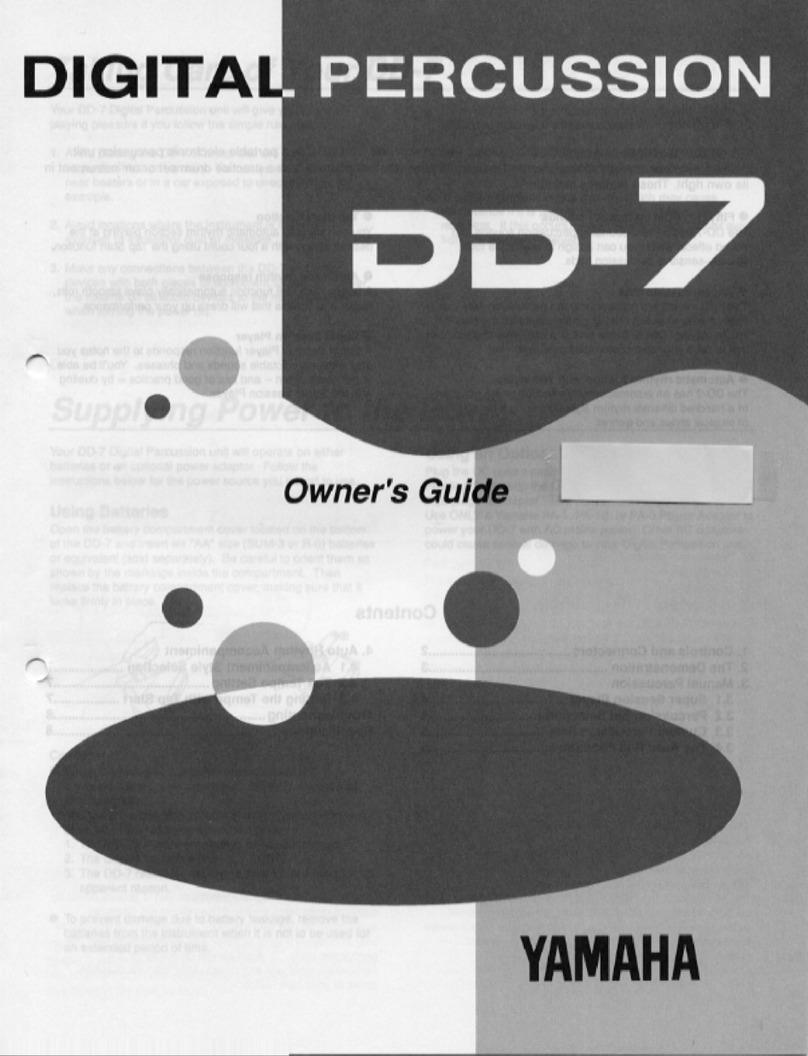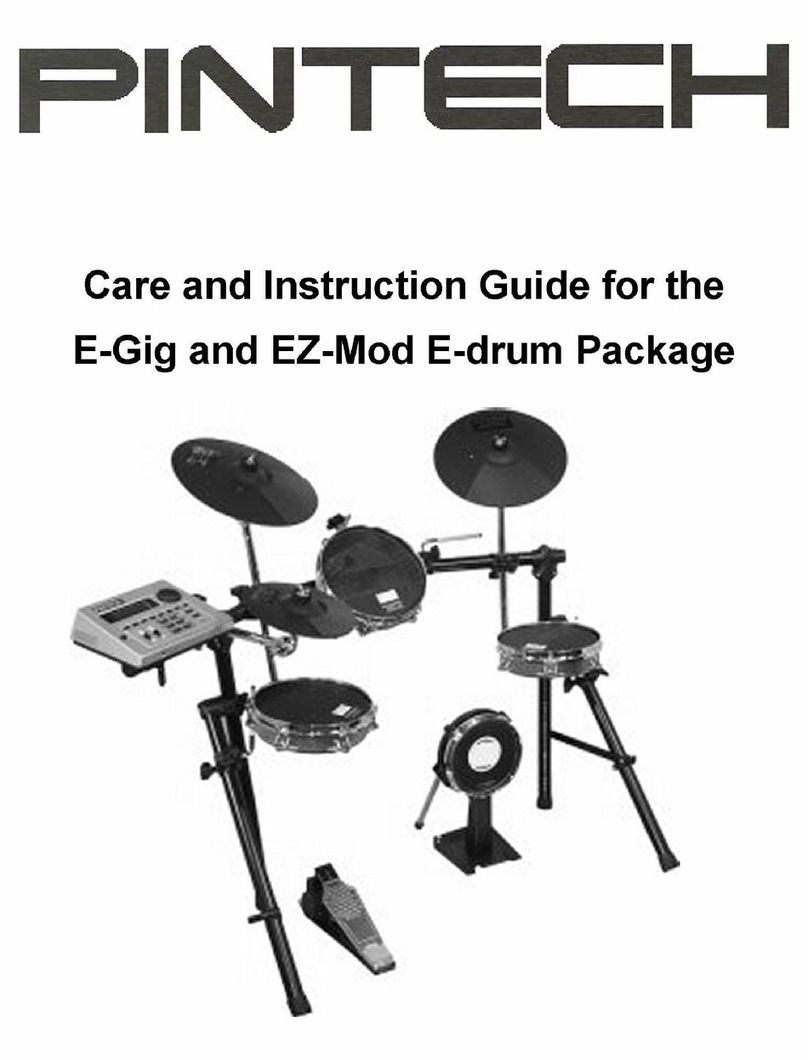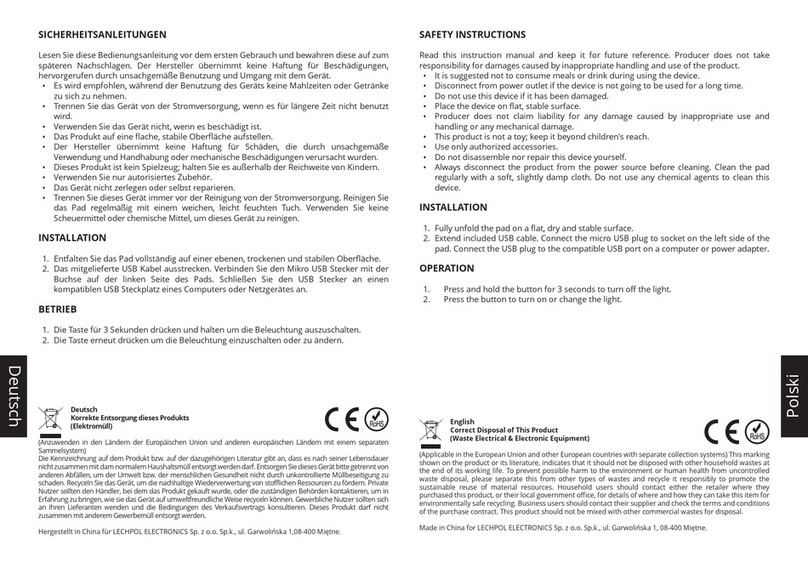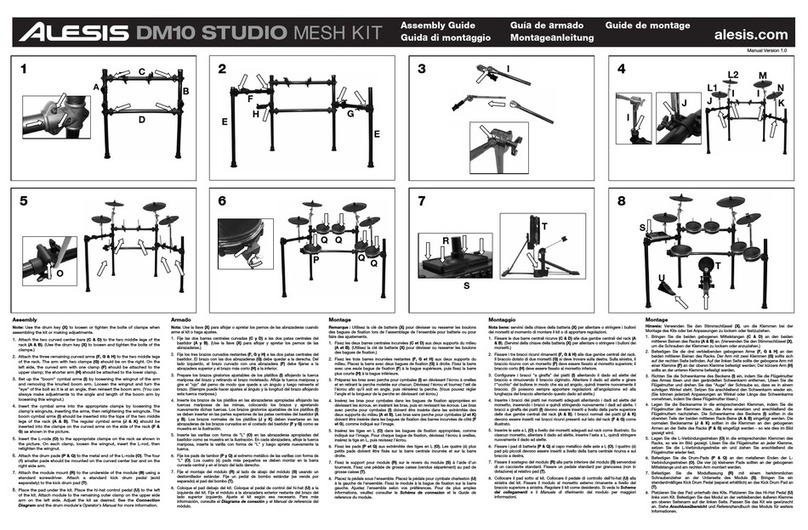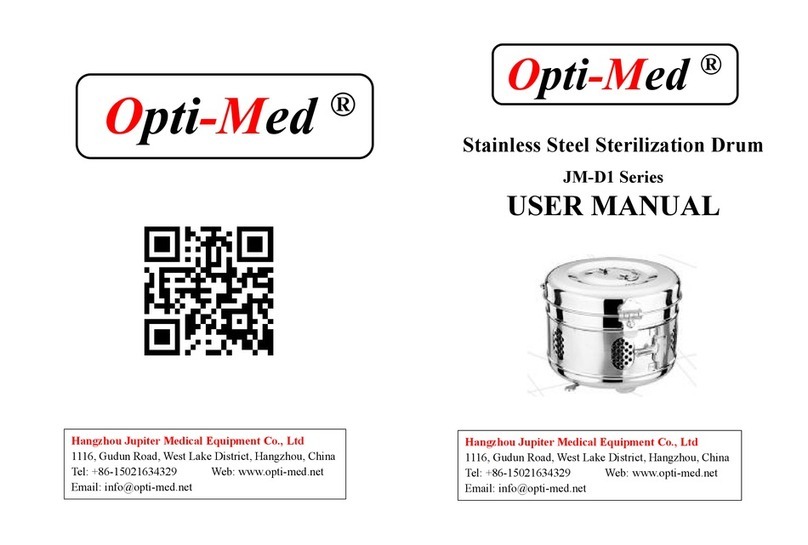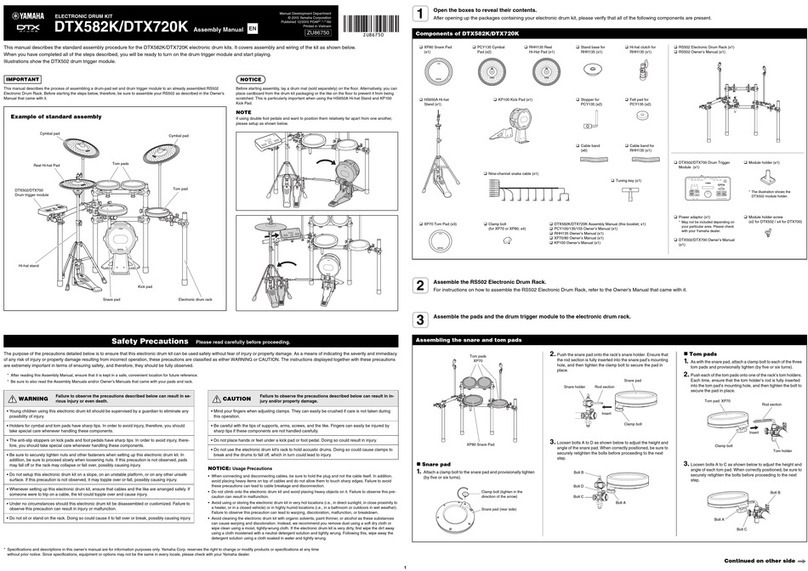
ÃSet the snare (PD-140DS), the ride cymbal (CY-18DR) and the hi-hat (VH-14D)
1. Use the cursor buttons to select “OK”, and press [ENTER] button.
2. Use the cursor buttons to select “PD140DS”, “CY18DR”, or “VH14D”.
3. Use the dial to specify the Assign.
* You can’t specify the same assignment multiple times.
The rst time you connect the PD-140DS, CY-18DR and VH-14D to the DIGITAL TRIGGER IN port,
the following screen will appear. As directed in the screen, assign the PD-140DS as snare, assign
the CY-18DR as ride, and assign the VH-14D as hi-hat.
* If you specify the same trigger input as a pad that is connected to a dedicated connection cable or TRIGGER IN
jack, the pad that’s connected to that TRIGGER INPUT jack and TRIGGER IN jack won’t produce sound.
Pad Assign
PD140DS SNARE
CY18DR RIDE
VH14D HI-HAT
Setting example
4. Press the [DRUM KIT] button to return to the DRUM KIT screen.
This completes settings.
ÃWhen you’ve nished making connections, turn on the power as described in “TD-27 Quick Start”, and verify that you
can hear sound.
This completes assembly and connections.
USING THE UNIT SAFELY IMPORTANT NOTES
Connect the pads to the
drum sound module
6
Connection procedure
* To prevent malfunction and equipment failure, always turn down the volume, and turn o all the units
before making any connections.
1. Connect the dedicated connection cable
to the TRIGGER INPUT connector on the
bottom panel of the drum sound module.
Insert the connector all the way, then turn the
knobs to fasten it securely.
Knob
2. Labels indicating the pad to be connected
are attached to the cable. Connect the
cable to the OUTPUT jack of each pad as
shown in the illustration at right.
3. Using the included trigger cable, connect
crash 2 to the CRASH 2 jack of the TRIGGER
IN jack on the back panel of the drum
sound module.
Drum sound module side
Cymbal side
4. Using the included connection cables,
connect the snare (PD-140DS), ride
(CY-18DR) and hi-hat (VH-14D) to the
DIGITAL TRIGGER IN ports of the drum
sound module.
* You may connect to any of the ports 1–3.
Fasten the cables so that they will not obstruct
your playing; use cable clips and cable ties.
Make sure to wrap the cable ties around the
pipes.
* Insert the plug rmly,
making sure it’s all the
way in.
As seen from the back of TD-27KV2
T1
T3
KIK
T2
CR1
Dedicated connection cable
Trigger cable (Crash 2)
Connection cable (Snare, Ride, Hi-hat)
KIK
Labels attached to the end of the cable
Crash 2
Ride
Snare
TD-27
CR1
7Connect the AC adaptor
and speakers
* To prevent malfunction and equipment failure, always turn down the volume,
and turn o all the units before making any connections.
Connect the AC adaptor, headphones, or speakers.
* Use the cord hook located on the bottom of the unit to secure the AC
adaptor cord as shown in the illustration.
Cord
Hook
The cord of
the supplied
AC Adaptor
AC outlet
WARNING
Use only the stand that is recommended
This unit should be used only with a stand
(MDS-Standard 2) that is recommended by Roland.
Do not place in a location that is unstable
When using the unit with a stand (MDS-Standard 2)
recommended by Roland, the stand must be carefully
placed so it is level and sure to remain stable. If not using
a stand, you still need to make sure that any location you choose
for placing the unit provides a level surface that will properly
support the unit, and keep it from wobbling.
Precautions regarding placement of this unit on a
stand
Be sure to follow the instructions in the Owner’s Manual
carefully when placing this unit on a stand (Refer to“TD-27KV2
Setup Guide”).
If it is not set up properly, you risk creating an unstable situation
which could lead to the unit falling or the stand toppling, and
may result in injury.
WARNING
Be cautious to protect children from injury
Always make sure that an adult is on hand to provide
supervision and guidance when using the unit in places
where children are present, or when a child will be using
the unit.
Take care not to get burned
Otherwise, you risk causing damage or malfunction.
CAUTION
Use only the specied stand(s)
This unit is designed to be used in combination with
specic stands (MDS-Standard 2) manufactured by
Roland. If used in combination with other stands, you
risk sustaining injuries as the result of this product dropping
down or toppling over due to a lack of stability.
Additional Precautions
• Use a reasonable amount of care when using the unit’s sensors;
and when using its jacks and connectors. Rough handling can
lead to malfunctions.
• This instrument is designed to minimize the extraneous sounds
produced when it’s played. However, since sound vibrations
can be transmitted through oors and walls to a greater degree
than expected, take care not to allow these sounds to become
a nuisance others nearby.
• This document explains the specications of the product at the
time that the document was issued. For the latest information,
refer to the Roland website.
Intellectual Property Right
• It is forbidden by law to make an audio recording, video
recording, copy or revision of a third party’s copyrighted work
(musical work, video work, broadcast, live performance, or
other work), whether in whole or in part, and distribute, sell,
lease, perform, or broadcast it without the permission of the
copyright owner.
• Do not use this product for purposes that could infringe on a
copyright held by a third party. We assume no responsibility
whatsoever with regard to any infringements of third-party
copyrights arising through your use of this product.
• The copyright of content in this product (the sound waveform
data, style data, accompaniment patterns, phrase data, audio
loops and image data) is reserved by Roland Corporation.
• Purchasers of this product are permitted to utilize said content
(except song data such as Demo Songs) for the creating,
performing, recording and distributing original musical works.
• Purchasers of this product are NOT permitted to extract
said content in original or modied form, for the purpose of
distributing recorded medium of said content or making them
available on a computer network.
• The SD logo and SDHC logo are trademarks of SD-
3C, LLC.
• ASIO is a trademark and software of Steinberg Media
Technologies GmbH.
• This product contains eParts integrated software platform of
eSOL Co.,Ltd. eParts is a trademark of eSOL Co., Ltd. in Japan.
• The Bluetooth® word mark and logos are registered trademarks
owned by Bluetooth SIG, Inc. and any use of such marks by
Roland is under license.
• This Product uses the Source Code of μT-Kernel under T-License
2.0 granted by the T-Engine Forum (www.tron.org).
• Roland, BOSS, and V-Drums are either registered trademarks or
trademarks of Roland Corporation in the United States and/or
other countries.
• Company names and product names appearing in this
document are registered trademarks or trademarks of their
respective owners.
About WARNING and CAUTION Notices
Used for instructions intended to alert the
user to the risk of injury or material
damage should the unit be used
improperly.
* Material damage refers to damage or
other adverse eects caused with
respect to the home and all its
furnishings, as well to domestic animals
or pets.
Used for instructions intended to alert the
user to the risk of death or severe injury
should the unit be used improperly.
The symbol alerts the user to things that must be
carried out. The specic thing that must be done is
indicated by the design contained within the circle. In the
case of the symbol at left, it means that the power-cord
plug must be unplugged from the outlet.
The symbol alerts the user to important instructions or
warnings.The specic meaning of the symbol is
determined by the design contained within the triangle. In
the case of the symbol at left, it is used for general
cautions, warnings, or alerts to danger.
The symbol alerts the user to items that must never be
carried out (are forbidden). The specic thing that must
not be done is indicated by the design contained within
the circle. In the case of the symbol at left, it means that
the unit must never be disassembled.
About the Symbols
ALWAYS OBSERVE THE FOLLOWING
CAUTION
Evaluate safety issues before using stands
Even if you observe the cautions given in the owner’s
manual, certain types of handling may allow this product
to fall from the stand, or cause the stand to overturn.
Please be mindful of any safety issues before using this product.
Avoid climbing on top of the unit, or placing heavy
objects on it
Otherwise, you risk injury as the result of the unit
toppling over or dropping down.
Disconnect all cords/cables before moving the unit
Damage or malfunction may result if you fail to
disconnect all cables before moving the unit.
Cautions when moving this unit
If you need to move the instrument, at least two persons
are required to safely lift and move the unit. It should be
handled carefully, all the while keeping it level.
Take care so as not to get ngers pinched
When handling the following moving parts, take care
so as not to get ngers, etc., pinched. An adult should
always be in charge of handling these items.
• Stands
• Pedals
Keep small items out of the reach of children
To prevent accidental ingestion of the parts listed below,
always keep them out of the reach of small children.
Included Parts:
• Cable clip
• Cable tie
Removable Parts:
• Screws
• Washers
• Nuts
• Felt washers
• Wing bolts
• Drum key
• Springs
• Hand knobs
Figure A: Setting for a Left-Handed Player
Curve pipe R
Cymbal mount
Pad mount
Assembly for a Left-Handed Player
The settings explained in this guide are for a right-handed player. If you want to set up for a left-handed player, assemble the
drum stand according to the procedure described in “Assembling the stand for a left-handed player” in the “MDS-Standard 2
Owner’s Manual”. Also, install the pads as shown in the Figure A.
¹Connect the cables to the OUTPUT jack of each pad as shown in the Figure B.
¹Using the included trigger cable, connect crash 2 to the CRASH 2 jack of the drum sound module.
Figure B: As seen from the back of TD-27KV2
T1
T3
KIK
T2
CR1
Ride
Crash 2
Snare
TD-27
Hi-hat
Hi-hat
ÃAdjust the hi-hat (VH-14D)
When using the VH-14D, be sure to adjust the oset and hi-hat on the TD-27 after connecting.
This adjustment is required in order to correctly detect open, close, and pedal operations.
NOTE
* Continuous playing may cause dis-coloration of the pad, but this will not
aect the Pad’s function.
* See the VH-14D Owner’s Manual for details on the hi-hat.
Fixing the cables
Secure the cable in place
with the cable tie
Leave some slack in
the cable
Be sure to make this
small plastic hook
visible from
you.
Wind a cable tie around the
pipe and tighten it in order
not to slip.
Wind a cable tie around a
cable.
Insert the small plastic
hook to a hole to secure
the cable to the cymbal
arm.
1. Press the [SYSTEM] button.
2. Use the cursor buttons to select “TRIGGER”, and
then press the [ENTER] button.
3. Use the cursor buttons to select “HI-HAT”, and
then press the [ENTER] button.
The TRIGGER HI-HAT screen appears.
* “VH-14D” is not shown as a Trig Type when the VH-14D is
not connected or if it is not assigned as the hi-hat. In this
case, connect the VH-14D and assign it as the hi-hat.
4. Press the [F5] (OFFSET) button.
The VH OFFEST ADJUSTMENT screen appears.
5. Loosen the clutch screw of the top cymbal and
let it sit on the bottom cymbal.
* Do NOT touch the hi-hats or the pedal.
Clutch screw
6. Press the [F5] (EXECUTE) button.
The “VH Oset” parameter is set automatically
(approx. 3 seconds).
7. Press the [KIT] button to return to the DRUM
KIT screen.
Adjusting the oset
Adjusting the hi-hat
1. Adjust the gap between the top cymbal and bottom
cymbal to a clearance of approximately 10 mm, then
tighten the clutch screw.
Clutch screw
10 mm
* Although the gap can be adjusted to a clearance that makes
playing the hi-hat easier, setting too narrow or wide a gap can cause
improper function of the unit and prevent the hi-hat from sounding
as you intend. Setting the gap to 10 mm provides the most natural
feel when playing the VH-14D.
2. Change the spring tension by adjusting the hi-hat
stand.
For instructions on adjusting the tension, refer to the
owner’s manual for your hi-hat stand.
* If the spring tension is too high or too low, the hi-hat may not
operate correctly and you might not be able to play the way you
intended.
* The tension may not be adjustable on some stands.
